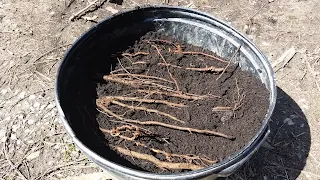.jpg) |
| I am mystified by how she can stay clean and photogenic doing this kind of work when I look like I was dredged through a tar-pit afterward. |
Super-model Mrs ERJ and I moved a tree from the nursery on our property to the location selected by Handsome Hombre.
My plan is to plant a tree for each grandchild. Today we moved a 10' tall Bur Oak that I grew from an acorn. Ten feet tall is about as big as I want to dig up and move even when Mrs ERJ does most of the work.
I like Bur Oaks (Quercus macrocarpa). They are not fussy about soil. They can take wet. They can take dry. They can take cold. They can take fire.
White Oak is a far superior timber tree because it is self pruning and generates a much higher percentage of "clear" timber. But White Oak is fussier about growing conditions. It will not tolerate wet soils and might be slightly fussier about soils with high pH.
A point in favor of oak trees in general is that they appear to have a great deal of north-south plasticity. Quercus texana which has the Arkansas/Missouri line as the northernmost extent of its natural range grows handsomely in my part of Michigan and in Wisconsin. Bur Oak has a natural range that spans from Corpus Christi, Texas in the south to Winnipeg, Manitoba in the north; Montreal in the east and Wyoming in the west.
Climate can do whatever it wants for the next 500 years, but Bur Oak has a genetic endowment that should allow it to take anything that happens in Michigan in stride without breaking a sweat.
Another thing I like about Bur Oak is the variability in leaf form. Some look like 50 year old farmer wives. They are stout without much indentation.
Others are so deeply incised as to look like fish skeletons.
And everything in between. Juvenile leaves can be different than mature leaves. Sun leaves can be different than shade leaves. Leaves on suckers can be enormous. Leaves on old trees can be smaller.
What attracted me to this tree out of the others in the nursery is that the twigs were "thick". They had a difficult-to-define robustness about them that spoke of an inherent vigor.
Planting trees is a crap shoot. Urban planners expect street trees to have a median life expectancy of about thirty years. Cars, salt, weed-trimmers and bunny-rabbits all take a toll on urban trees. Trees in rural areas have other risk factors.
Regardless, an oak tree from the White Oak or Live Oak clade can outlive not just my unborn grandchild but their as-yet-unborn grandchildren should God smile upon it.
Other planting news
 |
| Another inch or so of potting soil was added above these root cuttings. |
There is a gentleman in Kentucky (but I repeat myself) who sent me some root cuttings from his plum tree.
Most species of native plums are thicket formers and cheerfully reproduce from damaged roots.
If you embiggen the images you can see little sprigs of green on them. Those are shoots that are raring to go.
The exact plum species of these root cuttings is Chickasaw Plum. Botanists believe that the species originated in Oklahoma but Native Americans were so impressed with the fruit quality that they helped it migrate to places like Florida.
Its southern range means that it can survive a pounding of heat and humidity. Most specimens are very resistant to fungal and bacterial diseases like mildews and cankers.
Thank-you, Lucky.




"There are several bur oaks growing in Yellowknife, NWT."
ReplyDeleteI saw this online.
So the plum tree I cut down last fall...if I dig up around the stump and cut pieces of the root, I can possibly get a tree or two out of it?
ReplyDeleteI, too, am a fan of bur oak...have seedlings from across much of its range, from TX to Manitoba. Acorn size ranges from 6/lb to >100/lb. Some have prodigious fringe on acor caps, some none. Some have thick 'corky' bark on 1st yr twigs, others have little to none.
ReplyDeleteI, too, am a fan of bur oak...have seedlings from across much of its range, from TX to Manitoba. Acorn size ranges from 6/lb to >100/lb. Some have prodigious fringe on acor caps, some none. Some have thick 'corky' bark on 1st yr twigs, others have little to none.
ReplyDeleteI also like bur oaks for the reasons you mentioned. I used to use their large acorns (with caps) as ammo in my wrist rocket. One time, I drilled myself in the back of my support hand that held the grip...ouch. Chickasaw plums are beautiful in the early spring here. You can easily pick them out in the barren woods because their numerous blooms make them look like they are covered in snow.
ReplyDeleteWe have a few with leaves like that ERJ, although I doubt the same variety. The leaves always do make me happy though.
ReplyDeleteOur wives always look better than us working outdoors. This is just the way of it.